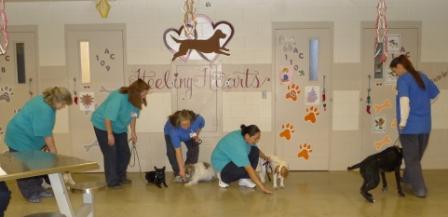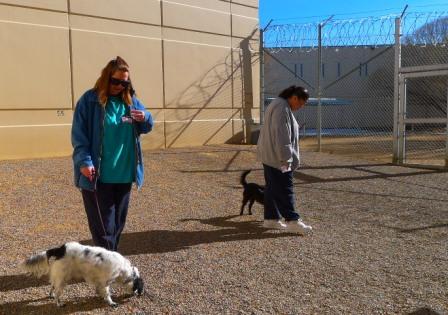
shelter dogs and women prisoners
teach each other to heal
It doesn’t matter how long you’re in for — in prison it’s too long. And while there are worse places to do time than the New Mexico Women’s Correctional Facility, with its motivational hallway banners and cheerful murals, prison is still a trap tighter than whatever dilemma helped land you here.
Only one thing lightens this dismal daily reality, and that’s the complete and utter joy of your canine roommate, who couldn’t be happier than to be locked up with you 24 hours a day. No matter what this creature suffered before being abandoned to the Grants Animal Control Shelter, your constant love and companionship seems to be all it could ever want. And how good does that make you feel, in your baggy prison garb?
“We heal them, and they heal us too,” says Marcia Lee, who started her 7-year term in 2008. She was one of the first inmates to be selected for Heeling Hearts, a program that pairs shelter dogs with inmates for training until the dogs are adopted. The program is unique in that adopters come to the prison itself for the meet-and-greet. Currently 16 inmates train dogs, but the waiting list is more than 50 names long.
Nine of those trainers live in “A” pod, a medium-security unit housing 25 inmates. Here in a two-story cement room ringed by cells, with a common area in the center, the dogs live with their handlers 24/7. Every morning they do an hour of formal training, followed by some recreational time. Five times a day they go out for potty break to a small gravel interior yard. Every few months, dogs and handlers are rotated so no one gets too attached.
“Letting go is the hardest part,” admits Lee, who like many of the prisoners shows none of the laughing affability of most American women. When your sole source of comfort is taken away, or gets adopted, the pain can be devastating — as well as instructive.
“I broke down,” says Ellen Snyder, stroking Jana, a mixed-breed terrier who was her first dog in prison. “I had a hard time even going to the potty yard, because I knew I’d see her.” Snyder, who has done 17 months of a five-year sentence, now lives with her second dog.
Meanwhile, long-timer Nandis Axelsen can barely remember the names of the 26 or more dogs she’s trained since she started the program in 2008. Now 65, Axelson has been in prison for more than 12 years.
“Dogs give us normalcy,” explains Snyder, “especially for those who had dogs outside. Having them changes you.”
“I’d be lonely without them,” adds Dana Eicher, incarcerated since 2003, with two more years to go. “It’s pretty lonely in here.”

The lucky few who get to be in Heeling Hearts must earn the privilege through good conduct. Only low- and medium-security prisoners can participate, since the higher-security pods don’t have the freedom to work the dogs outside. Yet, many inmates at the prison who don’t qualify still crave contact with dogs, and are allowed to request visits when going through a tough period emotionally.
“Personally, I think the inmates can identify with the dogs,” says Assistant Warden James Lopez. “In prison it’s hard to give a person the opportunity to care for another being. If you give them that, it will only do good.”
Good results probably account for the steady growth in prison dog-training programs nationwide, but Heeling Hearts — a program of Albuquerque’s PB&J Family Services, a parenting agency that includes prison-related support for families — is the only one currently operating in New Mexico. Lopez, who was previously warden of the Penitentiary of New Mexico, south of Santa Fe, introduced dogs to his maximum-security facility after seeing the impact at the Women’s Correctional Facility.
Winning support for such programs can be tougher than it might appear. Lopez began by bringing a couple of dogs from the Santa Fe Animal Shelter to his prison for a few hours, then a few more dogs for overnight visits. That sparked what many people fear — rough play with the dogs — which Lopez nipped in the bud by asking the prisoners how they’d feel, thrust into such a rowdy environment. “They really bought into that,” he says with satisfaction.
For dog owners, the positive, calming influence of pets might seem like a no-brainer. But resistance can be strong to offering therapeutic benefits in prison. Arlene Hickson, warden at the Women’s Correctional Facility, says she was one who opposed dog training when it was proposed at her previous post, at a Colorado prison. “It’s a thought process that inmates are bad people, and the last thing we want to do is introduce animals, with all the liability. I said absolutely not.”
It took seeing the benefits elsewhere to shift her thinking. When she transferred to the privately run women’s prison in June 2008, Heeling Hearts was already in place. Now Hickson is such a huge fan, “when PB&J lost funding for the program, I was ready to pay for it myself (out of our budget),” she says. “It’s a win-win all around.” The prison now covers expenses to feed the animals. In five years the program has adopted out 275 dogs, with no incidents of animal abuse.
In fact, units with dogs have fewer problems, Hickson notes. Prison dogtraining programs elsewhere have been found to reduce recidivism. And Heeling Hearts has the added benefit of running on a shoestring: The inmates teach each other how to train and groom the dogs, and the two women from Heeling Hearts who launched the program are now donating all their time.
“These are women, and by nature women take care,” Donna Howard, assistant public information officer at the prison, says of the inmates. “And some who haven’t done that because they were using drugs are doing it now, and that will help them with re-entering society.”
As the only women’s prison in New Mexico, the Grants facility houses more than 600 inmates from around the state, including all populations and types of offenses. Outsiders don’t often pause to consider, in thinking about such a place, that prisoners lose more than their freedom, individuality, privacy, and opportunity. They also lose the chance to make a positive contribution to society.
But when it comes to the dogs, Lopez notes, these women are actually saving lives.
“Some of the dogs come in abused,” says Hickson, “with challenges” — including the dog she herself adopted, who you’d never guess was a victim of abuse. The canine residents of A pod seem better behaved than most family dogs. Each one must pass the American Kennel Club’s Canine Good Citizen test before being offered for adoption.
To show off, Jana, the terrier mix, stands on her toes and twirls, executes ground rolls, and runs through a battery of tricks at the wave of a hand. Jana’s main obstacle now is that she doesn’t want to leave, and keeps flunking her meet-and-greets by showing none of her usual charisma.
And why shouldn’t the dogs be happy? When the prison suffers a lockdown, and inmates are confined to their cells until the whole facility has been searched — a process that can take days — “the dogs handle it better than we do,” says Snyder. A guard takes the dogs out on potty breaks, but otherwise they are on lockdown too. Having a companion makes it a lot easier for the humans to cope, adds Snyder. Dogs endure worse living in shelters or on the end of a chain. Their easy joy shows the women that life is worth living not to make yourself happy, but to bring happiness to someone else.
“We learn responsibility, respect, love,” says Lee, who believes dog therapy could help prevent incidents like the Sandy Hook massacre. In prison, or after a life of abandonment, women and dogs learn that love can set you free.
